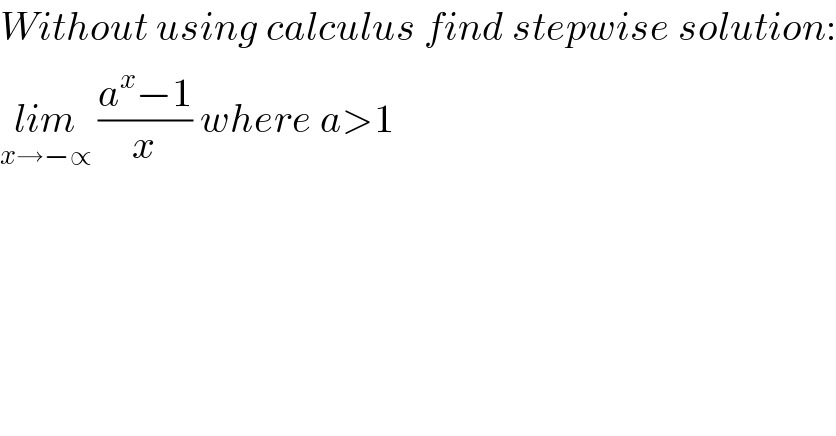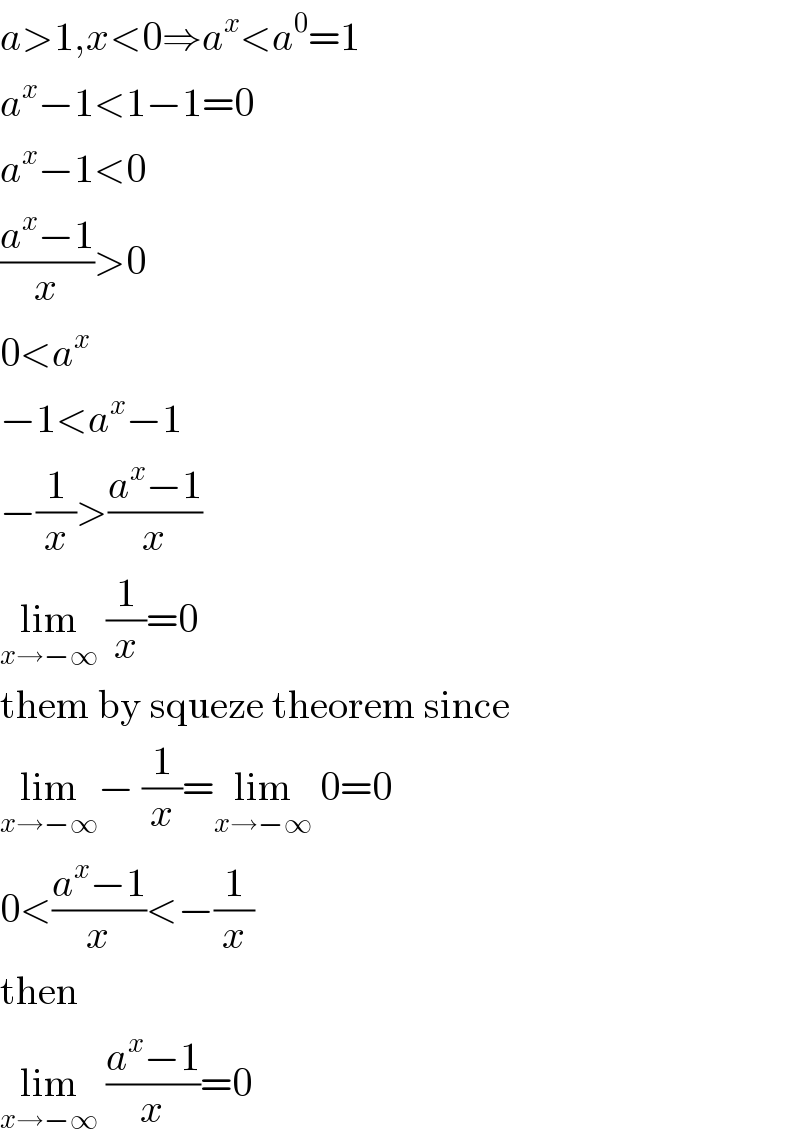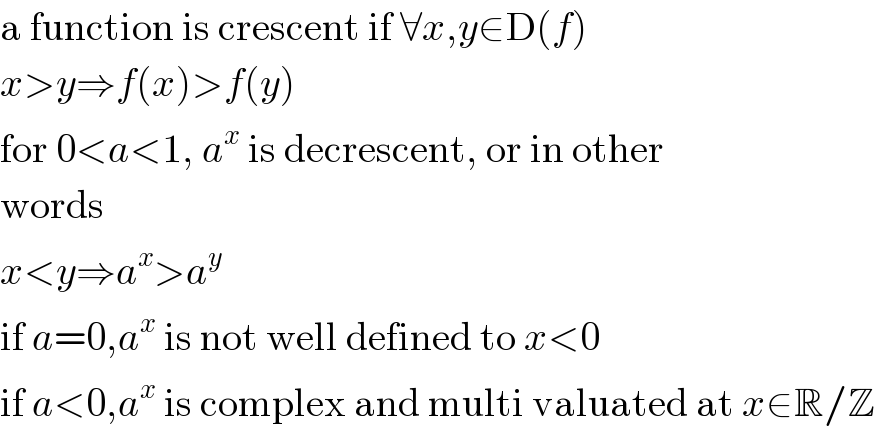
Question Number 1466 by Rasheed Soomro last updated on 10/Aug/15

$${Without}\:{using}\:{calculus}\:{find}\:{stepwise}\:{solution}: \\ $$ $$\underset{{x}\rightarrow−\propto} {{lim}}\:\frac{{a}^{{x}} −\mathrm{1}}{{x}}\:{where}\:{a}>\mathrm{1} \\ $$
Answered by 123456 last updated on 11/Aug/15

$${a}>\mathrm{1},{x}<\mathrm{0}\Rightarrow{a}^{{x}} <{a}^{\mathrm{0}} =\mathrm{1} \\ $$ $${a}^{{x}} −\mathrm{1}<\mathrm{1}−\mathrm{1}=\mathrm{0} \\ $$ $${a}^{{x}} −\mathrm{1}<\mathrm{0} \\ $$ $$\frac{{a}^{{x}} −\mathrm{1}}{{x}}>\mathrm{0} \\ $$ $$\mathrm{0}<{a}^{{x}} \\ $$ $$−\mathrm{1}<{a}^{{x}} −\mathrm{1} \\ $$ $$−\frac{\mathrm{1}}{{x}}>\frac{{a}^{{x}} −\mathrm{1}}{{x}} \\ $$ $$\underset{{x}\rightarrow−\infty} {\mathrm{lim}}\:\frac{\mathrm{1}}{{x}}=\mathrm{0} \\ $$ $$\mathrm{them}\:\mathrm{by}\:\mathrm{squeze}\:\mathrm{theorem}\:\mathrm{since} \\ $$ $$\underset{{x}\rightarrow−\infty} {\mathrm{lim}}−\:\frac{\mathrm{1}}{{x}}=\underset{{x}\rightarrow−\infty} {\mathrm{lim}}\:\mathrm{0}=\mathrm{0} \\ $$ $$\mathrm{0}<\frac{{a}^{{x}} −\mathrm{1}}{{x}}<−\frac{\mathrm{1}}{{x}} \\ $$ $$\mathrm{then} \\ $$ $$\underset{{x}\rightarrow−\infty} {\mathrm{lim}}\:\frac{{a}^{{x}} −\mathrm{1}}{{x}}=\mathrm{0} \\ $$
Commented byRasheed Ahmad last updated on 11/Aug/15
![1st line: a^x <1 ⇒ a^x −1<1−1 ⇒((a^x −1)/x) > ((1−1)/x) [ ∵ x<0 inequality reversed.] But 2nd line: ((a^x −1)/x)<((1−1)/x)=0 ??? [ ineq. not reversed?] Pl explain I want to learn from you.](Q1469.png)
$$\mathrm{1}{st}\:{line}:\:{a}^{{x}} <\mathrm{1} \\ $$ $$\Rightarrow\:{a}^{{x}} −\mathrm{1}<\mathrm{1}−\mathrm{1} \\ $$ $$\Rightarrow\frac{{a}^{{x}} −\mathrm{1}}{{x}}\:>\:\frac{\mathrm{1}−\mathrm{1}}{{x}}\:\:\:\:\:\:\left[\:\because\:{x}<\mathrm{0}\:\:{inequality}\right. \\ $$ $$\left.\:\:\:\:\:\:\:\:\:\:\:\:\:\:\:\:\:\:\:\:\:\:\:\:\:\:\:\:\:\:\:\:\:\:\:{reversed}.\right] \\ $$ $$\boldsymbol{\mathrm{But}} \\ $$ $$\mathrm{2}{nd}\:{line}:\:\frac{{a}^{{x}} −\mathrm{1}}{{x}}<\frac{\mathrm{1}−\mathrm{1}}{{x}}=\mathrm{0}\:??? \\ $$ $$\left[\:{ineq}.\:{not}\:{reversed}?\right] \\ $$ $$\boldsymbol{\mathrm{Pl}}\:\boldsymbol{\mathrm{explain}}\:\boldsymbol{\mathrm{I}}\:\boldsymbol{\mathrm{want}}\:\boldsymbol{\mathrm{to}}\:\boldsymbol{\mathrm{learn}}\:\boldsymbol{\mathrm{from}}\:\boldsymbol{\mathrm{you}}. \\ $$
Commented byRasheed Soomro last updated on 11/Aug/15

$$\mathrm{3}\boldsymbol{\mathrm{rd}},\mathrm{4}\boldsymbol{\mathrm{th}}\:\boldsymbol{\mathrm{and}}\:\mathrm{5}\boldsymbol{\mathrm{th}}\:\boldsymbol{\mathrm{lines}}: \\ $$ $$\frac{{a}^{{x}} −\mathrm{1}}{{x}}<\mathrm{0} \\ $$ $$\mathrm{0}<{a}^{{x}} \\ $$ $$\overset{?} {\Rightarrow}−\frac{\mathrm{1}}{{x}}<\frac{{a}^{{x}} −\mathrm{1}}{{x}}<\mathrm{0} \\ $$ $$\boldsymbol{\mathrm{As}}\:\boldsymbol{\mathrm{I}}\:\boldsymbol{\mathrm{think}},\boldsymbol{\mathrm{may}}\:\boldsymbol{\mathrm{be}}\:\boldsymbol{\mathrm{wrong}}\:: \\ $$ $$\frac{{a}^{{x}} −\mathrm{1}}{{x}}<\mathrm{0}\:\Rightarrow\frac{{a}^{{x}} }{{x}}−\frac{\mathrm{1}}{{x}}<\mathrm{0} \\ $$ $${a}^{{x}} >\mathrm{0}\:,\:{x}<\mathrm{0}\:\Rightarrow\:\:\frac{{a}^{{x}} }{{x}}<\mathrm{0}\:\overset{?} {\Rightarrow}−\frac{\mathrm{1}}{{x}}<\frac{{a}^{{x}} −\mathrm{1}}{{x}}<\mathrm{0}\: \\ $$ $$\boldsymbol{\mathrm{H}}{ow}\:−\frac{\mathrm{1}}{{x}}<\mathrm{0}\:?\:\:{While}\:\:{according}\:{to}\:{you}\:{x}<\mathrm{0}? \\ $$
Commented by123456 last updated on 11/Aug/15

$$\mathrm{sorry}\:\mathrm{by}\:\mathrm{the}\:\mathrm{mistakes}\::\mathrm{v} \\ $$ $$\left.\mathrm{i}\:\mathrm{forgot}\:\mathrm{these}\:\mathrm{details},\:\mathrm{thank}\:\mathrm{you}\::\right) \\ $$
Commented byRasheed Soomro last updated on 11/Aug/15

$${Please}\:{rewrite}\:\:\:{your}\:{answer}\::\:{a}\:{mistake}−{free}\:\:{answer}.\: \\ $$ $${Actually}\:{I}\:{didn}'{t}\:{mean}\:{to}\:{complain}\:{about}\:{lack}\:{of}\:{detail}\:{of} \\ $$ $${steps}.{I}\:{only}\:{wanted}\:{to}\:{be}\:{satisfied}\:{about}\:{the}\:{logic}\:{of}\:{your} \\ $$ $${solution}. \\ $$ $$\:{I}\:{am}\:{deeply}\:\:{interested}\:{in}\:{your}\:{solution}.{I}\:{will}\:{be}\:\boldsymbol{\mathrm{Thankful}}\:{if} \\ $$ $${you}\:{rewrite}\:{your}\:{answer}\:{for}\:{me}. \\ $$
Commented byRasheed Soomro last updated on 12/Aug/15

$$\boldsymbol{\mathrm{THANKS}}\:\boldsymbol{\mathrm{a}}\:\boldsymbol{\mathrm{lot}}!\:\boldsymbol{\mathrm{Now}}\:\boldsymbol{\mathrm{I}}\:\boldsymbol{\mathrm{think}}\:\boldsymbol{\mathrm{the}}\:\boldsymbol{\mathrm{logic}}\:\boldsymbol{\mathrm{is}}\:\boldsymbol{\mathrm{perfect}}. \\ $$
Answered by 123456 last updated on 12/Aug/15

$$\mathrm{we}\:\mathrm{have}\:\mathrm{that}\:\mathrm{for}\:{a}>\mathrm{1},\:{a}^{{x}} \:\mathrm{is}\:\mathrm{crescent},\:\mathrm{then} \\ $$ $${x}<\mathrm{0}\Rightarrow{a}^{{x}} <{a}^{\mathrm{0}} =\mathrm{1}\Rightarrow{a}^{{x}} <\mathrm{1} \\ $$ $$\mathrm{and}\:\mathrm{then} \\ $$ $${a}^{{x}} −\mathrm{1}<\mathrm{1}−\mathrm{1}=\mathrm{0}\Rightarrow{a}^{{x}} −\mathrm{1}<\mathrm{0}\:\:\left(−\mathrm{1}\:\mathrm{in}\:\mathrm{both}\:\mathrm{side}\right) \\ $$ $$\frac{{a}^{{x}} −\mathrm{1}}{{x}}>\mathrm{0}\:\left(\boldsymbol{\div}{x},\:\mathrm{and}\:\mathrm{sonce}\:{x}<\mathrm{0},\:<\:\mathrm{turn}\:\mathrm{into}\:>\right) \\ $$ $$\mathrm{we}\:\mathrm{have}\:\mathrm{that}\:{a}^{{x}} >\mathrm{0},\:\mathrm{then} \\ $$ $${a}^{{x}} −\mathrm{1}>−\mathrm{1}\:\left(−\mathrm{1}\:\mathrm{in}\:\mathrm{both}\:\mathrm{sides}\right) \\ $$ $$\frac{{a}^{{x}} −\mathrm{1}}{{x}}<−\frac{\mathrm{1}}{{x}}\:\left(\boldsymbol{\div}{x},{x}<\mathrm{0}\right) \\ $$ $$\mathrm{then} \\ $$ $$\mathrm{0}<\frac{{a}^{{x}} −\mathrm{1}}{{x}}<−\frac{\mathrm{1}}{{x}} \\ $$ $$\mathrm{then}\:\mathrm{the}\:\mathrm{squeze}\:\mathrm{theorem}\:\mathrm{work}\:\mathrm{by}\:\mathrm{this}\:\mathrm{way} \\ $$ $$\mathrm{since}\: \\ $$ $$\frac{{a}^{{x}} −\mathrm{1}}{{x}}\:\mathrm{is}\:\mathrm{bounced}\:\mathrm{by}\:\mathrm{0}\:\mathrm{and}\:−\frac{\mathrm{1}}{{x}}\:\:\mathrm{and} \\ $$ $$\mathrm{0}\rightarrow\mathrm{0}\:\mathrm{and}\:−\frac{\mathrm{1}}{{x}}\rightarrow\mathrm{0}\:\mathrm{as}\:{x}\rightarrow−\infty \\ $$ $$\mathrm{then}\:\frac{{a}^{{x}} −\mathrm{1}}{{x}}\rightarrow\mathrm{0}\:\mathrm{as}\:{x}\rightarrow−\infty \\ $$ $$\mathrm{in}\:\mathrm{formal}\:\mathrm{way}\:\mathrm{remember}\:\mathrm{that} \\ $$ $$\underset{{x}\rightarrow−\infty} {\mathrm{lim}}\:{f}\left({x}\right)=\mathrm{L} \\ $$ $$\mathrm{only}\:\mathrm{if} \\ $$ $$\forall\epsilon>\mathrm{0},\exists\mathrm{M}\in\mathbb{R},\forall{x}<\mathrm{M},\mid{f}\left({x}\right)−\mathrm{L}\mid<\epsilon \\ $$ $$\mathrm{them} \\ $$ $$\underset{{x}\rightarrow−\infty} {\mathrm{lim}}\:\mathrm{0}\Leftrightarrow\mathrm{M}\in\left(−\infty,\mathrm{0}\right),{x}<\mathrm{M}\Rightarrow\mid\mathrm{0}−\mathrm{0}\mid<\epsilon \\ $$ $$\underset{{x}\rightarrow−\infty} {\mathrm{lim}}\:−\frac{\mathrm{1}}{{x}}=\mathrm{0}\Leftrightarrow\mathrm{M}\leqslant−\frac{\mathrm{1}}{\epsilon},{x}<\mathrm{M} \\ $$ $${x}<\mathrm{M}<\mathrm{0}\Rightarrow−\epsilon\leqslant\frac{\mathrm{1}}{\mathrm{M}}<\frac{\mathrm{1}}{{x}}<\mathrm{0}\Rightarrow\mathrm{0}<−\frac{\mathrm{1}}{{x}}<−\frac{\mathrm{1}}{\mathrm{M}}\leqslant\epsilon \\ $$ $$\mid−\frac{\mathrm{1}}{{x}}−\mathrm{0}\mid<\epsilon \\ $$ $$\mathrm{and}\:\mathrm{finaly},\:\mathrm{choose}\:\mathrm{the}\:\mathrm{same}\:\mathrm{M}\:\mathrm{above} \\ $$ $$\underset{{x}\rightarrow−\infty} {\mathrm{lim}}\:\frac{{a}^{{x}} −\mathrm{1}}{{x}}=\mathrm{0} \\ $$ $${x}<\mathrm{M} \\ $$ $$\mathrm{0}<\frac{{a}^{{x}} −\mathrm{1}}{{x}}<−\frac{\mathrm{1}}{{x}}<−\frac{\mathrm{1}}{\mathrm{M}}\leqslant\epsilon \\ $$ $$\mid\frac{{a}^{{x}} −\mathrm{1}}{{x}}−\mathrm{0}\mid<\epsilon \\ $$ $$\left.\mathrm{as}\:\mathrm{desired}\::\right) \\ $$
Commented byRasheed Ahmad last updated on 17/Aug/15

$$\mathrm{for}\:{a}>\mathrm{1},\:{a}^{{x}} \:\mathrm{is}\:\mathrm{crescent}..... \\ $$ $$\mathrm{what}\:\mathrm{is}\:\mathrm{the}\:\mathrm{meaning}\:\mathrm{of}\:'\mathrm{crescent}' \\ $$ $$\mathrm{If}\:{a}<\mathrm{1}\:\mathrm{what}\:\mathrm{term}\:\mathrm{will}\:\mathrm{be}\:\mathrm{used}? \\ $$ $$ \\ $$
Commented by123456 last updated on 28/Aug/15

$$\mathrm{a}\:\mathrm{function}\:\mathrm{is}\:\mathrm{crescent}\:\mathrm{if}\:\forall{x},{y}\in\mathrm{D}\left({f}\right) \\ $$ $${x}>{y}\Rightarrow{f}\left({x}\right)>{f}\left({y}\right) \\ $$ $$\mathrm{for}\:\mathrm{0}<{a}<\mathrm{1},\:{a}^{{x}} \:\mathrm{is}\:\mathrm{decrescent},\:\mathrm{or}\:\mathrm{in}\:\mathrm{other} \\ $$ $$\mathrm{words} \\ $$ $${x}<{y}\Rightarrow{a}^{{x}} >{a}^{{y}} \\ $$ $$\mathrm{if}\:{a}=\mathrm{0},{a}^{{x}} \:\mathrm{is}\:\mathrm{not}\:\mathrm{well}\:\mathrm{defined}\:\mathrm{to}\:{x}<\mathrm{0} \\ $$ $$\mathrm{if}\:{a}<\mathrm{0},{a}^{{x}} \:\mathrm{is}\:\mathrm{complex}\:\mathrm{and}\:\mathrm{multi}\:\mathrm{valuated}\:\mathrm{at}\:{x}\in\mathbb{R}/\mathbb{Z} \\ $$
Commented byRasheed Ahmad last updated on 28/Aug/15

$$\boldsymbol{\mathrm{Thanks}}! \\ $$
Answered by Rasheed Soomro last updated on 16/Aug/15

$$\frac{{a}^{{x}} −\mathrm{1}}{{x}}=\left({a}^{{x}} −\mathrm{1}\right)×\frac{\mathrm{1}}{{x}} \\ $$ $$\underset{{x}\rightarrow−\propto} {{lim}}\:\frac{{a}^{{x}} −\mathrm{1}}{{x}}=\underset{{x}\rightarrow−\propto} {{lim}}\:\left({a}^{{x}} −\mathrm{1}\right)×\underset{{x}\rightarrow−\propto} {{lim}}\left(\frac{\mathrm{1}}{{x}}\right) \\ $$ $$\:\:\:\:\:\:\:\:\:\:\:\:\:\:\:\:\:\:\:\:\:\:\:\:\:\:\:=\left(\:\underset{{x}\rightarrow−\propto} {{lim}}\:{a}^{{x}} −\underset{{x}\rightarrow−\propto} {{lim}}\left(\mathrm{1}\right)\:\right)×\underset{{x}\rightarrow−\propto} {{lim}}\left(\frac{\mathrm{1}}{{x}}\right) \\ $$ $${Now}\:\underset{{x}\rightarrow−\propto} {{lim}a}^{{x}} =\mathrm{0}\:\:{for}\:{a}>\mathrm{1},\:\underset{{x}\rightarrow−\propto} {{lim}}\left(\mathrm{1}\right)=\mathrm{1}\:{and}\:\:\underset{{x}\rightarrow−\propto} {{lim}}\left(\frac{\mathrm{1}}{{x}}\right)=\mathrm{0} \\ $$ $${Hence}\: \\ $$ $$\:\:\underset{{x}\rightarrow−\propto} {{lim}}\:\frac{{a}^{{x}} −\mathrm{1}}{{x}}=\left(\mathrm{0}−\mathrm{1}\right)×\mathrm{0}=\mathrm{0} \\ $$ $$\:\:\underset{{x}\rightarrow−\propto} {{lim}}\:\frac{{a}^{{x}} −\mathrm{1}}{{x}}=\mathrm{0} \\ $$
Commented by123456 last updated on 16/Aug/15

$$\left.\mathrm{alright}.\::\right) \\ $$
